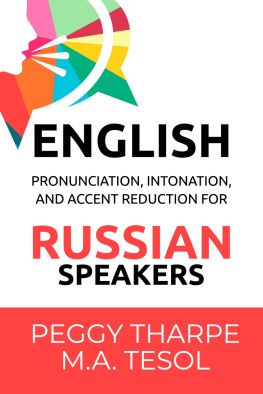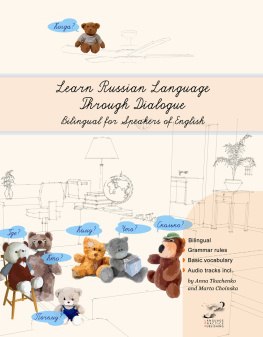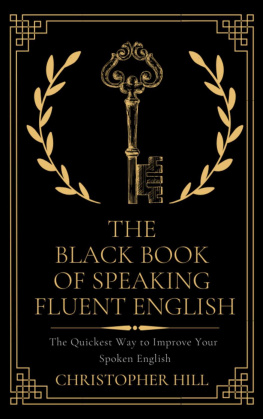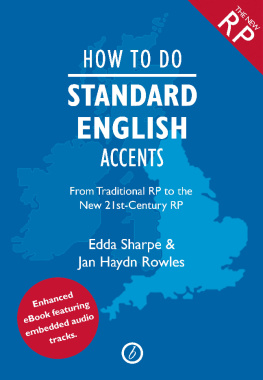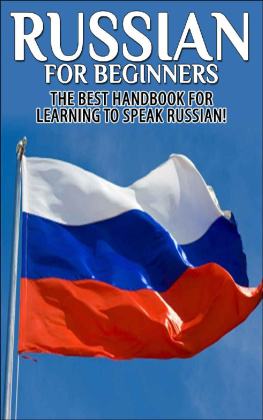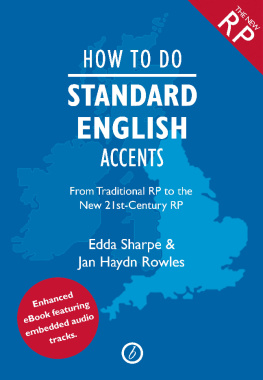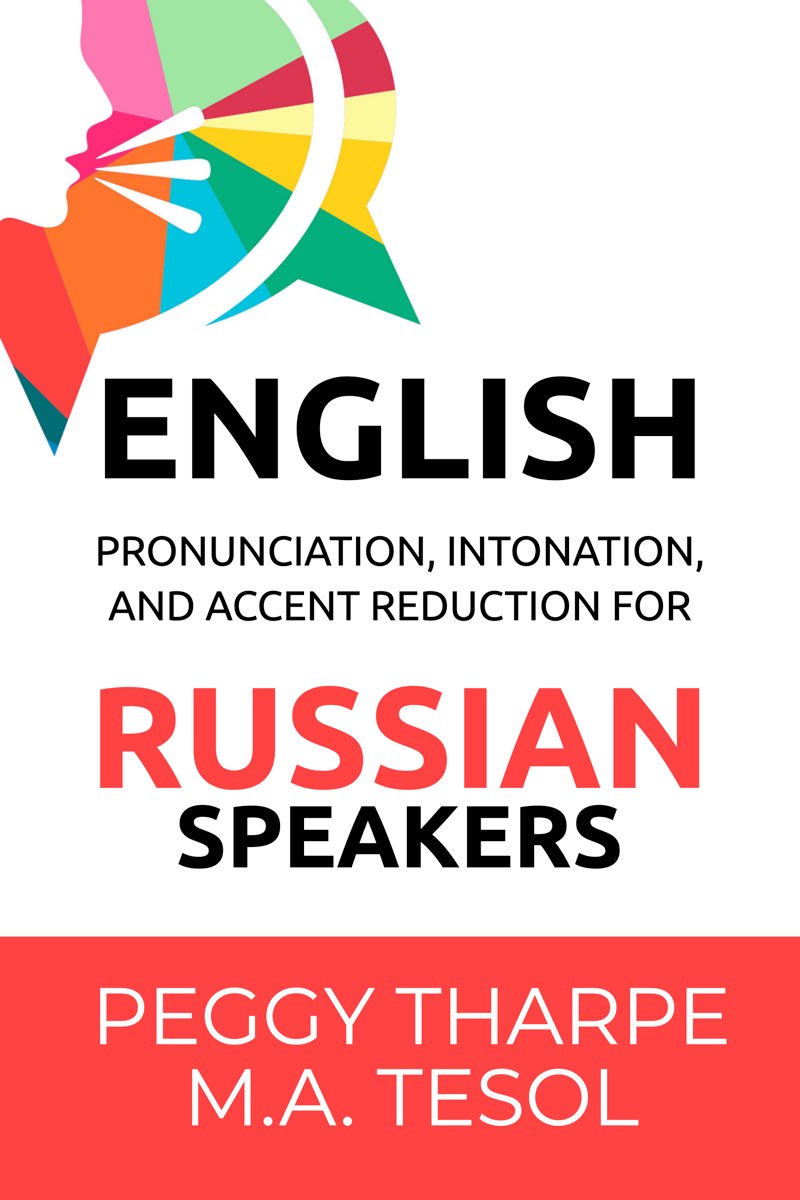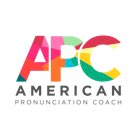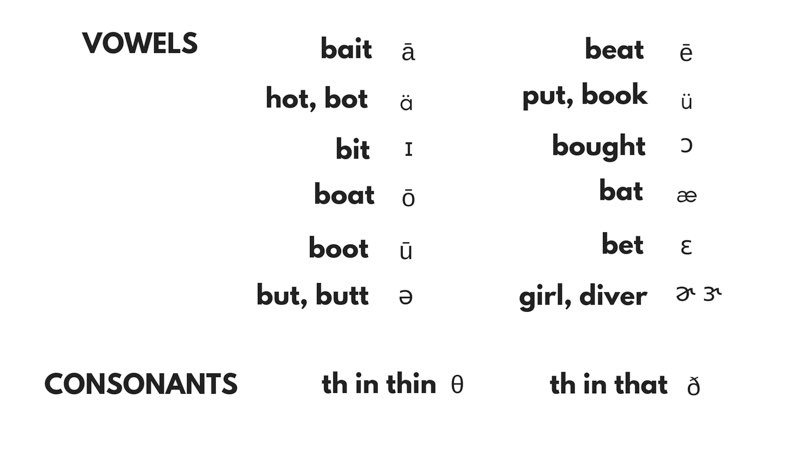English Pronunciation, Intonation and Accent Reduction For Russian Speakers
Peggy Tharpe
Copyright 2019 by Peggy A. Tharpe
Content Editor: Gina Mathis
Copy Editor: Carolyn Kernberger
All rights reserved.
This book or any portion thereof may not be reproduced or used in any manner whatsoever without the express written permission of the author except for the use of brief quotations in a book review.
Printed in the United States of America
First Printing, 2019
The URL addresses referenced in this book were live and correct at the time of publishing. The websites were functioning at the time of this books publication, but this may be subject to change.
Requests for permission to use should be directed to
This book is dedicated to my Russian students of English who showed me what they needed to know.
Until we learn to do otherwise
We hear with our first language ears
We speak with our first language tongues
And communicate with our first language code.
PEGGY THARPE
Contents
Preface
This book is for Russians studying English who are at an advanced level, working on pronunciation, intonation and accent. If your native language is Russian and youre ready to get rid of your accent in English, then read on!
It is also for ESL and EFL teachers, tutors, coaches and mentors who want to help their Russian-speaking students of English with their sound in English.
We will talk about the physicality of speaking, how it differs in Russian and English, and what to do about it. In the end, pronunciation is an action, not an intellectual pursuit!
Part 1 Getting Ready
Lets make our work together as productive as possible
I know you are ready to jump into this customized pronunciation project and start work, but before we do that, I want to share some things that will make your studies go more smoothly, for example, resources I reference, symbols I use, and features that have a significant effect on your sound in English.
Part 1 of this guide is the getting-ready sectionour meeting of the minds.
Welcome
How this guide is organized
Its so nice to have you join me. My name is Peggy Tharpe. I am an accent reduction and English fluency coach, and a lifetime ESL/EFL teacher.
Ive written this book for Russian English speakers and their teachers, tutors, and coaches and language fanciers. It covers the issues that I work on most and the strategies I use most with my advanced level Russian-speaking, English-studying clients to change their sound in English. If youd like to know more about me, my work and history, read my resume here.
When it comes to the sounds of Russian and English, we have a lot in common. In this guide, we will concentrate on big areas we dont have in common, and little areas that all English learners have to work on.
Were going to:
- Discuss how your first language affects your pronunciation of English
- Talk about how our modes of speaking differ and learn the English mode
- Add some missing vowels and change a few consonants
- Modify your word stress patterns to sound more like a native speaker of English
- Learn how pitch change differs in Russian and English
- Learn how intonation patterns differ in Russian and English
- Strengthen your ownership of the sound of English!
THIS GUIDE HAS 4 PARTS
PART 1 compares English and Russian sound systems. If you are a student of English and find Part 1 difficult to understand, go to Part 2 and start working on your vowels. But please come back to Part 1 because its full of important information you need to know. Part 1 also tells what symbols and materials we will use throughout this guide.
PART 2 is all about the construction materials you need to create your English soundvowels. Youll learn why they are hard to change and what you need to do differently to gain control over these raw materials so you can speak with a more natural stress, rhythm, and intonation.
PART 3 addresses your other building materialsconsonant sounds. Youll find lots of practice activities to help you change these critical markers needed by your listeners to recognize the words you are saying.
PART 4 is extremely important for you as a native Russian speaker. We will talk about what you must do to dispel confusion regarding your intentions and attitudes. Part 4 covers pitch and tone, which make a huge difference in how your message is received by English native speakers and is quite different between Russian and English. Tone is very important in English, more than you can imagine. Tone use strongly affects how people perceive you and interpret what youve said.
PART 5 is where we say good-bye, exchange numbers, and promise to keep in touch!
Symbols for English Sounds
And the online dictionary I want you to use
We wont be able to use English letters to talk about English sounds because there is no exact one-to-one correlation. The letter A, for example, can make a long A sound as in date, a short A sound like bat, an AH sound like father, or an AW sound, like lawn.
Looking at it the other way, from sounds to spellings, the long A sound //can be spelled like date, weight, hay, nail or bouquet. So you and I must come to an agreement about symbols and sounds before we begin talking about sounds.
Over the decades, many phonetic symbol systems have been created. They are all generally referred to as IPA International Phonetic Alphabets. They are systems originally designed by and for linguists to identify and catalog all the sounds made in all the worlds languages. But IPAs are unnecessarily complicated and confusing as a study tool. Unfortunately, there is no new, modern system that everyone agrees on.
Some people still use the old IPA, while others, like myself, now use a simpler system. On the next page are the symbols I will use for English sounds we will be working on in this book.
IMPORTANT NOTE ABOUT SYMBOLS USED
Most of the symbols I use are for vowel sounds because English doesnt have a strong correlation between vowel spelling and vowel sounds. You may see me comparing sounds with or or symbols. And sometimes Ill use letters to indicate sounds, for example UH and AH. I use what helps me communicate the easiest and hopefully, it isnt confusing for you.
Consonants have a stricter one-to-one relationship between letter and sound than vowel sounds, so I need fewer, non-letter, however we will use two differing symbols for TH because there are two possible sounds.
BEFORE YOU BEGIN
First check your online dictionary and your other pronunciation tools and resources to determine what symbols they use. During our time together, I want you to use Merriam-Webster for your online dictionary: m-w.com. M-W and I differ slightly on a few symbols, but the pronunciation recordings are in American English, and thats important for you.

